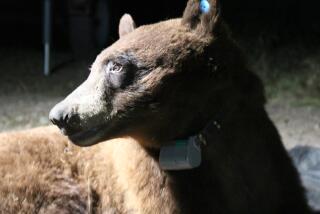Federal Study Tracks Effect of Acorn Shortage on the Diet of Black Bears
- Share via
THORNTON GAP, Va. — It was 8 a.m. and Jim Kraus and John Kasbohm were loaded for bear.
That is, with tranquilizers, syringes, tape measures, a scale and a collar that emits radio signals. The two researchers were off to check a trap they had set in the Shenandoah National Park.
Near Hawksbill Gap they found a bear, snared by a front paw, that henceforward would be known as “Female 120” in a $136,000 federal study of the effect of gypsy moth infestations of trees on the black bears in the park.
Earlier this summer, the moths munched through about 20,000 acres of oak forest, mostly north of Thornton Gap.
The trees have grown some new leaves but they won’t be producing many acorns, the equivalent of potatoes in the black bear’s prehibernation diet.
Scientists hope to trap about 35 of the 700 bears in the park, fit them with the $300 radio collars and then keep track of their movements to learn how they react to the acorn shortage.
Data for Management
The study is important, said Kasbohm, “to the management of bears in the park. . . . We need to gain information so we know what’s ahead of us.”
The moth, with its preference for the oak trees that make up 60% of the park’s forest, is expected to be well established throughout the park by 1990. By then, overpopulation and an endemic virus carried by the moth will begin curbing the insects’ numbers.
The study gained attention recently after Prince William County, Va., police shot and killed another of its research subjects, “Male 342.” The animal somehow had made its way more than 75 miles east into the heavily populated suburbs of Washington, D.C.
Although no one knows why Male 342 wandered so far from the park, the shooting in wildlife-management parlance is an “adverse contact” between man and beast. Scientists who work in the park fear there will be more of them if the bears descend from an acorn-depleted park into surrounding farm land and subdivisions to feed in orchards and garbage cans.
Prince William County police were criticized by state game officials and the public for shooting the black bear, which is a shy species harmless to humans. The only recorded “bear attack” in Shenandoah occurred about seven years ago, when a hiker surprised a mother bear with cubs.
Rare Bear Attack
“She took a swat at him and clawed his chest,” said David Haskell, natural resources manager.
Female 120, snared Friday by Kasbohm and Kraus, also was a nursing mother, and as they prepared for the hourlong process of sedating and testing her, the two researchers scanned the treetops for her cubs. “They’ll be up there somewhere,” said Kraus, 32, as he assembled a 6-foot pole with a syringe full of drugs.
The two men flipped a coin to see who would jab the needle into the now-frantic bear’s behind, a job that requires considerable agility and nerve.
Kraus lost the toss and moved in on the target. A quick thrust of the pole, and Female 120 paused, sat down and nodded off.
Then began a long period of steady work as the bear was measured (just under 5 feet from nose tip to tail tip), marked with an ear tag and weighed in a complicated procedure of suspending her from a tree limb held above the men’s heads.
“One hundred thirty-two pounds,” said Kraus. “She’s a typical mother bear.”
Blood Samples Taken
Kasbohm, 23, then slid a needle into her thigh and drew blood samples that would go to Virginia Tech labs for testing. Blood analysis would indicate her state of health and hormone levels, which, in turn, would show where she was in the cycle of reproduction and approaching hibernation.
Bears are frequently the subjects of research. In fact, the Shenandoah bears earlier in this decade were subjects of a study, “which provides us with a lot of good base-line data,” Kraus said. Scientists have become increasingly interested in the body chemistry of hibernation, a four-month period when bears do not eat, yet females give birth and nurse their cubs.
Finally, before she awoke and stumbled drunkenly down the hillside, Female 120 was fitted with her collar, which would enable Kasbohm and Kraus, with the help of radio technician Barbara Greenewalt, to track her movements.
This winter, while the bear and her cubs are sleeping, Kasbohm and Kraus will enter the den, weigh the cubs and take more blood samples.
Runaway Bear Lost
The ill-fated Male 342 was last heard from on July 15, when he was located by air in the Massanutten Mountains west of the park. The next week, scientists flew more than 100 square miles trying to find his signal again.
By then he had vamoosed.
Scientists who are concerned that bears hungry for acorns may search for food outside the park want to make sure that they aren’t shot as nuisances. Beekeepers may want to put electric fences around their hives and farmers should store apples carefully, said Kasbohm.
More to Read
Sign up for Essential California
The most important California stories and recommendations in your inbox every morning.
You may occasionally receive promotional content from the Los Angeles Times.










